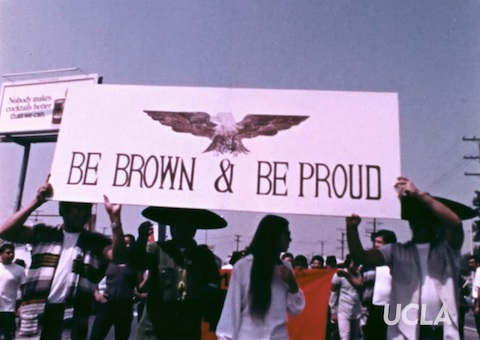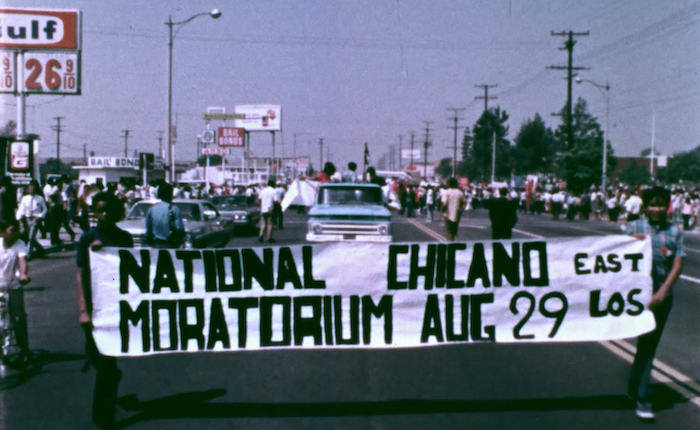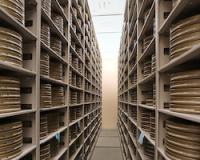
Chicano Moratorium: A Question of Freedom (1971)
On August 29, 1970, in East Los Angeles, more than 20,000 Chicana/o/x people marched in protest against the Vietnam War as part of the National Chicano Moratorium Movement. The aim of the march was to bring attention to the disproportionate percentage of Chicanos being killed daily in the war. The initially peaceful event, which began with a parade on Whittier Boulevard, turned violent when Los Angeles County Sheriff’s deputies confronted participants gathered in what was then called Laguna Park in East Los Angeles.
The Sheriff’s Department declared that the anti-war rally was an unlawful assembly and dispatched a large deployment of deputies who brutally attacked participants in the crowd with batons. In an attempt to flee the police violence, the crowd spilled into nearby streets as law enforcement continued pursuit, resulting in numerous clashes and incidents of property damage. Most significantly, the police actions of the day left dozens injured and resulted in the tragic deaths of three people (source). Among the dead was highly respected Los Angeles Times reporter and KMEX-TV news director Ruben Salazar, who was killed under suspicious circumstances by a tear gas projectile fired by a Sheriff’s deputy. In 1970, East Los Angeles' Laguna Park was renamed in honor of Salazar.

Chicano Moratorium: A Question of Freedom
As was common during this era, due to systemic biases against people of color, many local and national news media entities did not cover the events and aftermath of the march in a manner that fully addressed police accountability. One such example is evident in the NBC Nightly News broadcast of August 30, 1970, which frames shoplifting by marchers at a liquor store on Whittier Boulevard as a major catalyst for the day’s violence, without questioning the deadly magnitude and ferocity of the resulting police response nor interviewing march participants for their perspectives.
However, mainstream news crews weren’t the only ones covering the march. Loyola Marymount University student filmmaker Thomas Myrdahl and University of Southern California student producer Nick Sherbin were also on the scene in East Los Angeles that day. The young documentarians had also covered previous civil rights marches and sit-ins and considered themselves allies in the social justice movements for equality that were transforming the United States in the 1960s and early ’70s.

Chicano Moratorium: A Question of Freedom
“Coming home with damning film coverage, I knew I had parts of a story but needed help,” recalled Myrdahl. “I turned to Chicano filmmakers from UCLA, who were also bravely covering the march, and we exchanged footage so that a full story could be told. My hope was that in some way, my film would help Chicano leaders tell their story of racial repression in Los Angeles.”
The resulting 10-minute documentary, Chicano Moratorium: A Question of Freedom (1971), offers an alternative account of the march, cultural festivities, and violent police actions of that day.
“What we witness in the film is the vibrancy of the cultural renaissance and youth-led protest against the disproportionate deaths of Brown and Black men in Vietnam,” said Maylei Blackwell, associate professor in the UCLA César E. Chávez Department of Chicana/o and Central American Studies. “The film provides vital historical and visual documentation of the use of police violence in suppressing many youth movements led by communities of color in the late 1960s and ’70s, specifically the actions of the Los Angeles County Sheriff’s Department in their widespread repression and surveillance of the Chicano Movement in Los Angeles,” Blackwell said. “The Sheriff’s Department to this day has yet to account for the death of Los Angeles Times journalist Ruben Salazar.”

Chicano Moratorium: A Question of Freedom
In 2020, the UCLA Film & Television Archive reached out to Myrdahl, seeking to acquire his film for inclusion in the Archive’s collection. Two 16mm film prints of the documentary—one narrated in English and the other in Spanish—were donated to the Archive by Myrdahl. Both versions of the documentary are now available for free online viewing on the Archive’s YouTube channel.
Chicano Moratorium stands alongside the film Requiem-29 (1971)—named to the National Film Registry in 2021 and soon to be preserved by the UCLA Film & Television Archive in collaboration with the Library of Congress—as important documentary evidence and community accounts of the events of August 29, 1970.
Reflecting on his film Chicano Moratorium and its meaning today, Myrdahl said, “So many in the 1960s and ’70s faced danger, even death, to fight against prejudice and injustice. My hope is that people learn from the past and stand up and fight for a better future.”
Watch the film:
En español:
—Mark Quigley, John H. Mitchell Television Curator; Jennifer Rhee, Digital Content Manager.
< Back to the Archive Blog






 Mobile Navigation
Mobile Navigation

